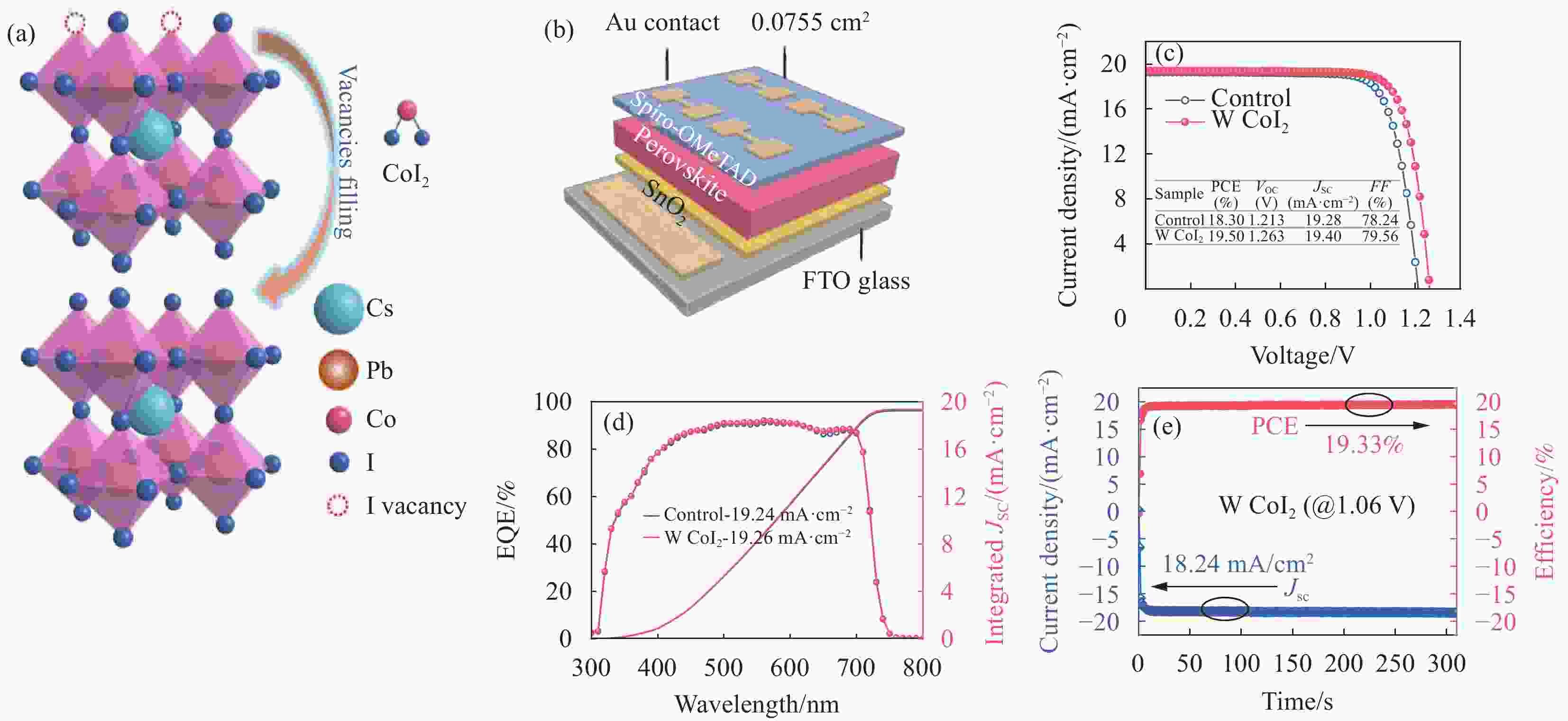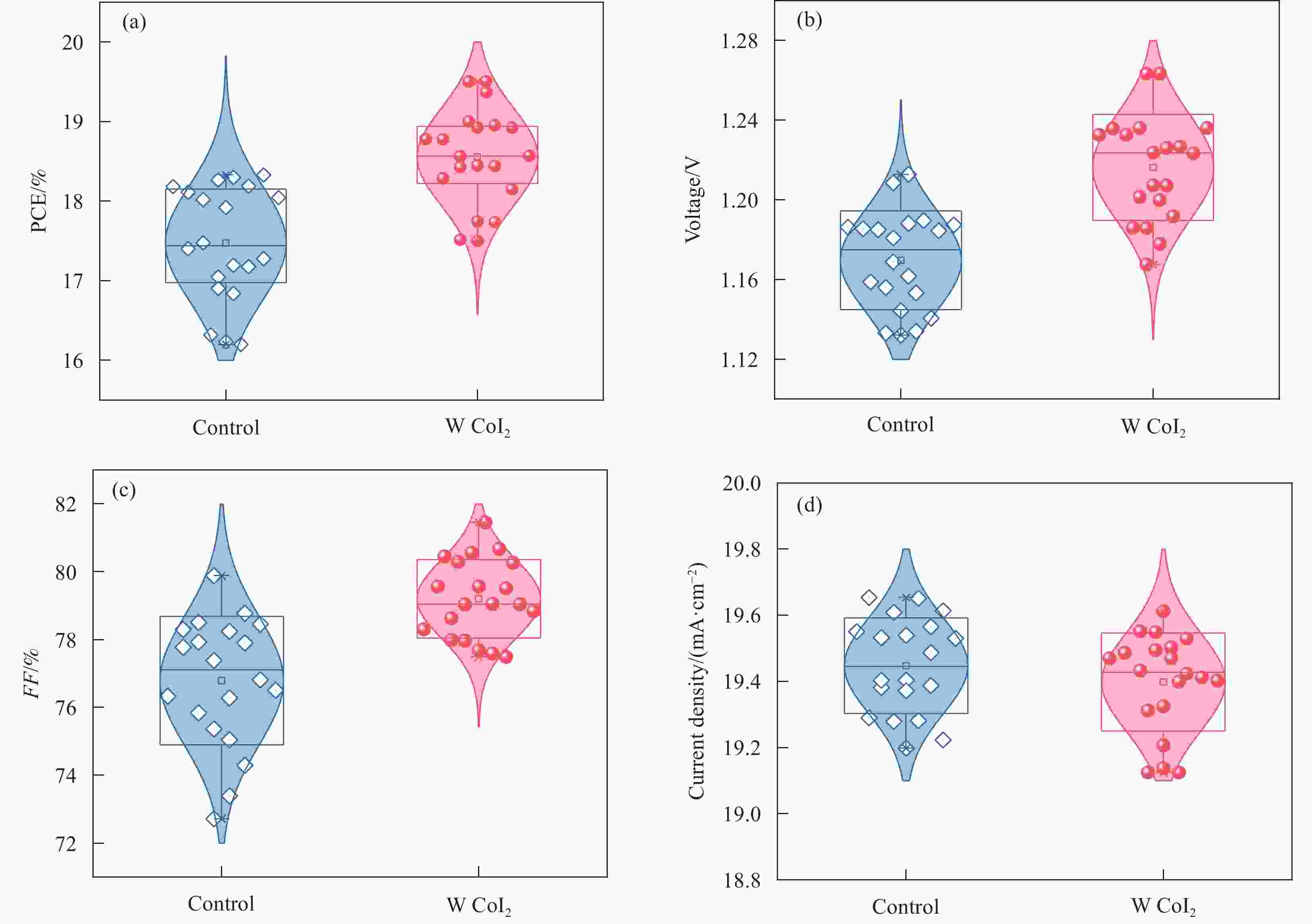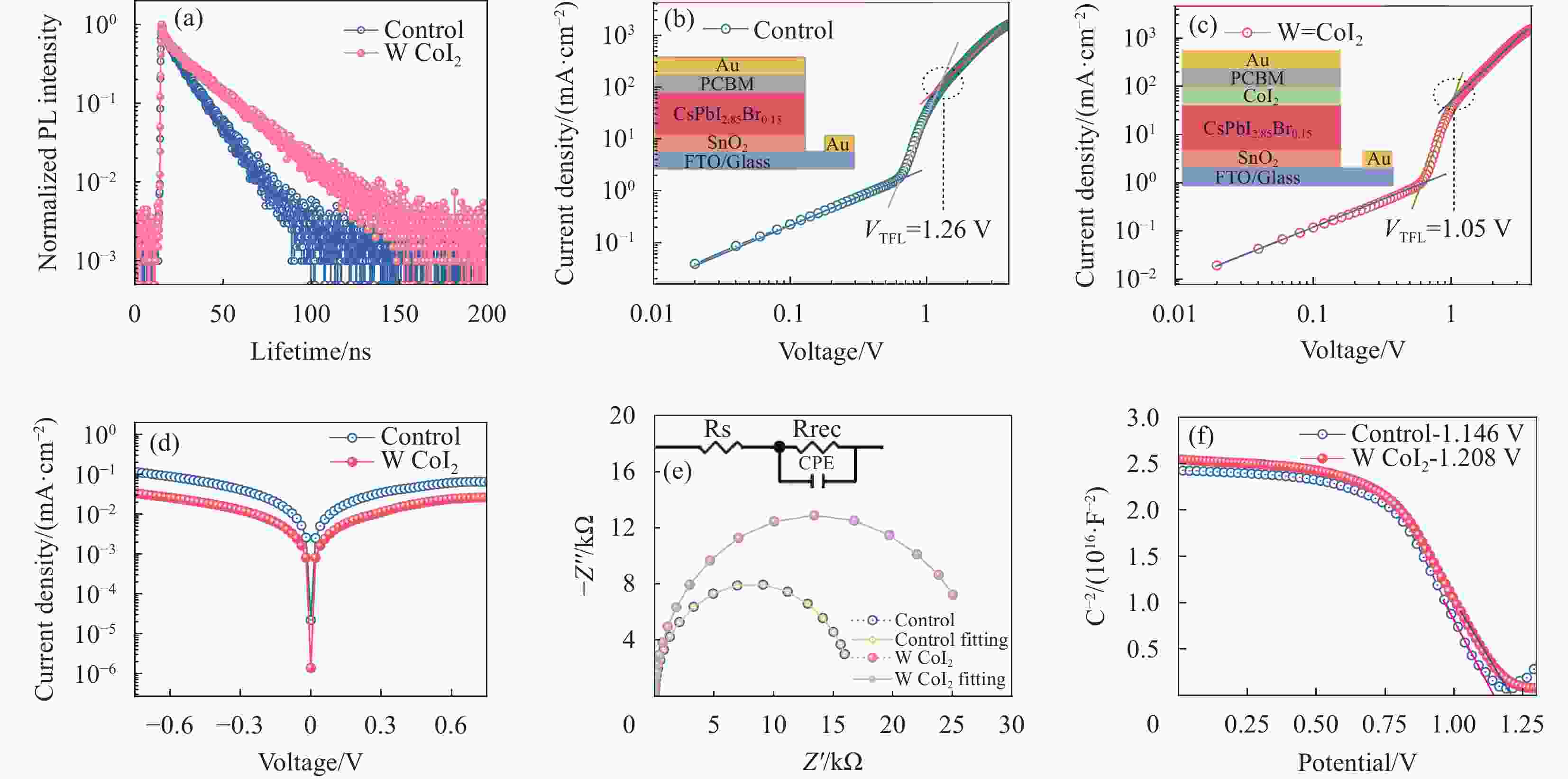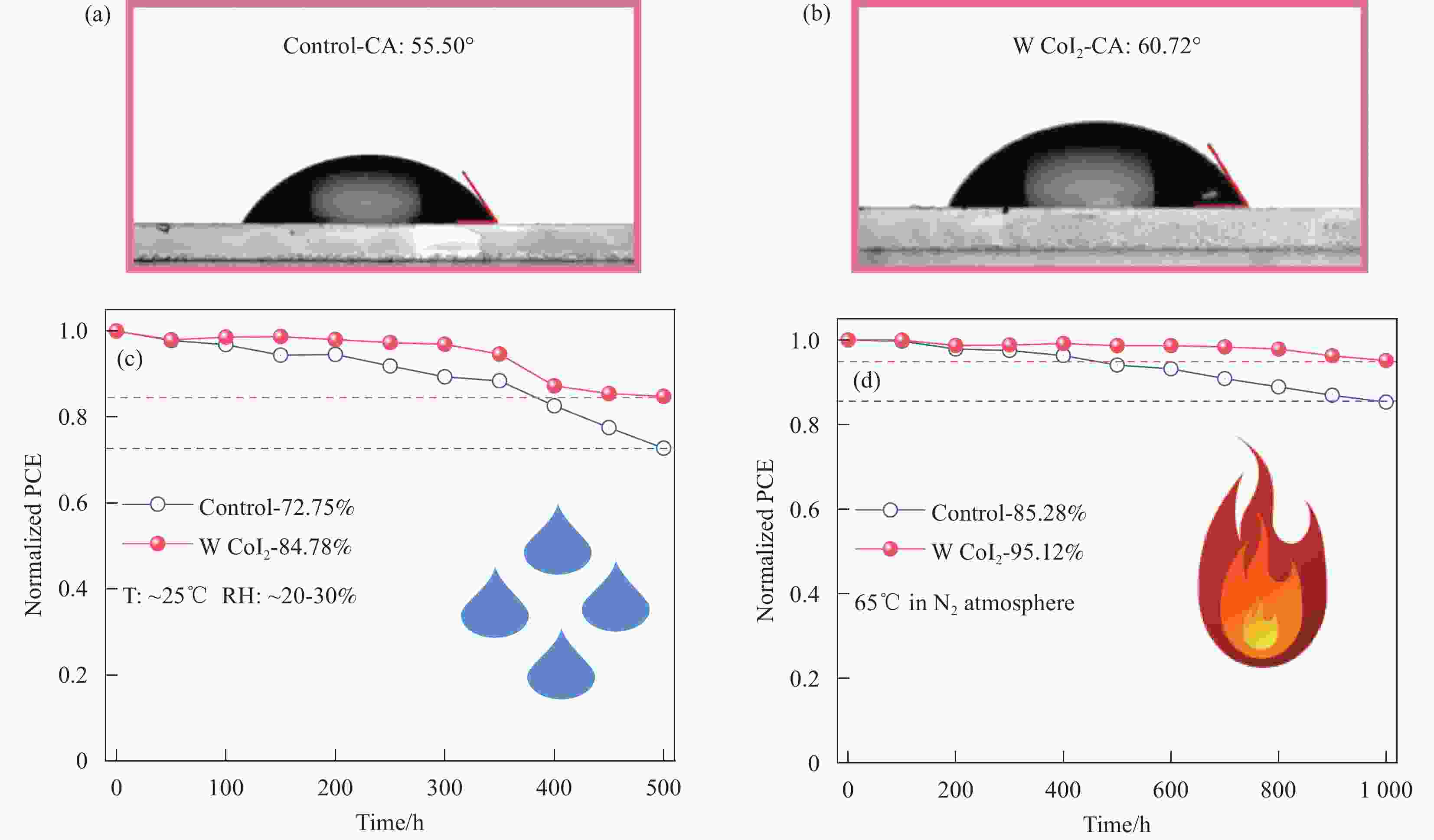High efficiency inorganic perovskite solar cells prepared by CoI2 inhibited interfacial non-radiation recombination
-
摘要: 无机钙钛矿太阳电池(Inorganic perovskite solar cells, IPSCs)因其优异的光、热稳定性引起了广泛关注。然而,由于界面处非常严重的非辐射复合,IPSCs往往面临着非常巨大的开路电压(VOC)损失。为解决这一问题,本文提出利用无机材料碘化钴(CoI2)抑制界面非辐射复合,在不引入有机材料的前提下增强IPSCs的光伏性能,实现界面缺陷的有效管理,降低非辐射复合,最终,基于CoI2界面处理的空气环境下制备的IPSCs实现了19.50%的光电转换效率,VOC损失仅仅为447 mV且稳定性优异,为有效降低IPSCs的VOC损失提供了新策略。Abstract: Inorganic perovskite solar cells (IPSCs) have attracted considerable attention due to their excellent light and thermal stability. However, IPSCs usually face extremely large open circuit voltage (VOC) deficits due to severe non-radiative recombination at the interface. To solve this issue, this research proposes to use inorganic material cobalt iodide (CoI2) to inhibit interface non-radiative recombination, enhance the photovoltaic performance of IPSCs without introducing organic materials, achieve effective management of interface defects, reduce non-radiative recombination. IPSCs prepared in air environment based on CoI2 interface treatment achieved a photoelectric conversion efficiency of 19.50%, and VOC loss was only 447 mV with excellent stability, providing a new strategy for effectively reducing VOC deficits of IPSCs.
-
图 2 (a) CoI2的作用机制示意图,(b) IPSCs器件结构示意图,(c) IPSCs的J-V测试曲线及光伏性能参数,(d) EQE测试曲线,(e)稳态功率输出(SPO)效率测试曲线
Figure 2. (a) Schematic diagram of the action mechanism of CoI2, (b) schematic diagram of IPSCs device structure, (c) J-V test curve of IPSCs and photovoltaic performance parameters, (d) EQE test curve, (e) steady-state power output (SPO) efficiency test curve
-
[1] WANG S, LI M. -H, ZHANG Y, et al. Surface n-type band bending for stable inverted CsPbI3perovskite solar cells with over 20% efficiency[J]. Energy & Environmental Science, 2023, 16(6): 2572-2578. [2] LIU N, LIU Z, WANG J, et al. Synchronous surface reconstruction and grain boundary healing toward efficient and stable inverted CsPbI3 perovskite solar cells[J]. Chemical Engineering Journal, 2024, 485; 149590. [3] YU B, TAN S, LI D, et al. The stability of inorganic perovskite solar cells: from materials to devices[J]. Materials Futures, 2023, 2(3): 032101. doi: 10.1088/2752-5724/acd56c [4] GUO, Q, WANG, C. Y, Hayat, T et al[J]. Recent advances in perovskite/organic integrated solar cells. Rare Metals, 2021, 40: 2763-2777. [5] WANG S, WANG P, SHI B, et al. Inorganic Perovskite Surface Reconfiguration for Stable Inverted Solar Cells with 20.38% Efficiency and Its Application in Tandem Devices[J]. Advanced Materials, 2023, 35(28): 2300581. doi: 10.1002/adma.202300581 [6] LANG K, GUO Q, HE Z, et al. High Performance Tandem Solar Cells with Inorganic Perovskite and Organic Conjugated Molecules to Realize Complementary Absorption[J]. The Journal of Physical Chemistry Letters, 2020, 11(22): 9596-9604. doi: 10.1021/acs.jpclett.0c02794 [7] WANG S; WANG P; CHEN B, et al. Suppressed recombination for monolithic inorganic perovskite/silicon tandem solar cells with an approximate efficiency of 23%[J]. eScience, 2022, 2(3): 339-346. doi: 10.1016/j.esci.2022.04.001 [8] CHEN CL, ZHANG SS, LIU TL et al. Improved open-circuit voltage and ambient stability of CsPbI2Br perovskite solar cells by incorporating CH3NH3Cl. Rare Metals. 2020, 39: 131-138. [9] GAO R, CHEN R, WAN P et al. High Efficiency Formamidinium-Cesium Perovskite-Based Radio-Photovoltaic Cells[J]. Energy & Environmental Materials, 2024, 7(1): e12513. [10] XU T, XIANG W, YANG J, et al. Interface Modification for Efficient and Stable Inverted Inorganic Perovskite Solar Cells[J]. Advanced Materials, 2023, 35(31): 2303346. doi: 10.1002/adma.202303346 [11] GUO X, JIA Z, LIU S, et al. Stabilizing efficient wide-bandgap perovskite in perovskite-organic tandem solar cells[J]. Joule, 2024, 8(7): 2123-2134. doi: 10.1016/j.joule.2024.05.005 [12] LI C, LI Y, CHEN Y, et al. Enhancing Efficiency of Industrially-Compatible Monolithic Perovskite/Silicon Tandem Solar Cells with Dually-Mixed Self-Assembled Monolayers[J]. Advanced Functional Materials, 2024: 2407805. [13] WANG K, TIAN Q, ZHAO G, et al. Beach-Chair-Shaped Energy Band Alignment for High-Performance β-CsPbI3 Solar Cells[J]. Cell Reports Physical Science, 2020, 1 (9). [14] LIU T, ZHAO X, ZHONG X, et al. Improved Absorber Phase Stability, Performance, and Lifetime in Inorganic Perovskite Solar Cells with Alkyltrimethoxysilane Strain-Release Layers at the Perovskite/TiO2 Interface[J]. ACS Energy Letters, 2022, 7(10): 3531-3538. doi: 10.1021/acsenergylett.2c01610 [15] ZHANG J, CHE B, ZHAO W, et al. Polar Species for Effective Dielectric Regulation to Achieve High-Performance CsPbI3 Solar Cells[J]. Advanced Materials, 2022, 34(41): 2202735. doi: 10.1002/adma.202202735 [16] FU S, LE J, GUO X, et al. Polishing the Lead-Poor Surface for Efficient Inverted CsPbI3 Perovskite Solar Cells[J]. Advanced Materials, 2022, 34(38): 2205066. doi: 10.1002/adma.202205066 [17] CHU X, YE Q, WANG Z, et al. Surface in situ reconstruction of inorganic perovskite films enabling long carrier lifetimes and solar cells with 21% efficiency[J]. Nature Energy, 2023, 8(4): 372-380. doi: 10.1038/s41560-023-01220-z [18] JIANG Y, XU T. -F, DU H. -Q, et al. Organic-inorganic hybrid nature enables efficient and stable CsPbI3-based perovskite solar cells[J]. Joule, 2023, 7 (12): 2905-2922. [19] XU T, XIANG W, KU D. J, et al. Simultaneous Lattice Engineering and Defect Control via Cadmium Incorporation for High-Performance Inorganic Perovskite Solar Cells[J]. Advanced Science, 2022, 9(36): 2204486. doi: 10.1002/advs.202204486 [20] YUAN J, ZHANG D, DENG B, et al. High Efficiency Inorganic Perovskite Solar Cells Based On Low Trap Density and High Carrier Mobility CsPbI3 Films[J]. Advanced Functional Materials, 2022, 32(47): 2209070. doi: 10.1002/adfm.202209070 [21] ZHANG S, ZHANG L, TIAN Q, et al. Spontaneous Construction of Multidimensional Heterostructure Enables Enhanced Hole Extraction for Inorganic Perovskite Solar Cells to Exceed 20% Efficiency[J]. Advanced Energy Materials, 2021, 12(1): 2103007. [22] HUANG J, WANG H, CHEN C, et al. Ionic Bilateral Passivator Carboxyethylisothiuronium Chloride for CsPbI3-xBrx Perovskite Solar Cells with PCE 20.9% and Superior Stability[J]. Materials Today, 2023, 67: 46-56. doi: 10.1016/j.mattod.2023.05.008 [23] TAN S, YU B, CUI Y, et al. Temperature-Reliable Low-Dimensional Perovskites Passivated Black-Phase CsPbI3 toward Stable and Efficient Photovoltaics[J]. Angewandte Chemie International Edition, 2022, 61(23): e202201300. doi: 10.1002/anie.202201300 [24] LI M. -H, MA X, FU J, et al. Molecularly tailored perovskite/poly(3-hexylthiophene) interfaces for high-performance solar cells[J]. Energy & Environmental Science, 2024, 17(15): 5513-5520. [25] LI R, ZHANG S, ZHANG H, et al. Customizing Aniline-Derived Molecular Structures to Attain beyond 22% Efficient Inorganic Perovskite Solar Cells[J]. Angewandte Chemie International Edition, 2024, 341: e202410600. [26] WANG S, QI S, SUN H, et al. Nanoscale Local Contacts Enable Inverted Inorganic Perovskite Solar Cells with 20.8% Efficiency[J]. Angewandte Chemie International Edition, 2024, 63(19): e202400018. doi: 10.1002/anie.202400018 [27] LIU Y, XIANG W, MOU S, et al. Synergetic surface defect passivation towards efficient and stable inorganic perovskite solar cells[J]. Chemical Engineering Journal, 2022, 447: 137515. doi: 10.1016/j.cej.2022.137515 [28] GU X, XIANG W, TIAN Q, et al. Rational Surface-Defect Control via Designed Passivation for High-Efficiency Inorganic Perovskite Solar Cells[J]. Angewandte Chemie International Edition, 2021, 60(43): 23164-23170. doi: 10.1002/anie.202109724 [29] WU W, XIONG H, DENG J, et al. Rotatable Skeleton for the Alleviation of Thermally Accumulated Defects in Inorganic Perovskite Solar Cells[J]. ACS Energy Letters, 2023, 8(5): 2284-2291. doi: 10.1021/acsenergylett.3c00535 [30] QIU J, MEI X, ZHANG M, et al. Dipolar Chemical Bridge Induced CsPbI3 Perovskite Solar Cells with 21.86 % Efficiency[J]. Angewandte Chemie International Edition, 2024, 63(18): e202401751. doi: 10.1002/anie.202401751 [31] YAO Z XU Z, ZHAO W, et al. Enhanced Efficiency of Inorganic CsPbI3−xBrx Perovskite Solar Cell via Self-Regulation of Antisite Defects[J]. Advanced Energy Materials, 2021, 11(23): 2100403. doi: 10.1002/aenm.202100403 [32] SUN H, WANG S, QI S, et al. Surface Defects Management by In Situ Etching with Methanol for Efficient Inverted Inorganic Perovskite Solar Cells[J]. Advanced Functional Materials, 2023, 33(23): 2213913. doi: 10.1002/adfm.202213913 [33] LUO M, WANG S, ZHU Z, et al. Novel cathode buffer layer enabling over 21.6%/20.9% efficiency in wide bandgap/inorganic perovskite solar cells[J]. Nano Energy, 2024, 121: 109162. doi: 10.1016/j.nanoen.2023.109162 [34] LU C, LI X, GUO X, et al. Efficient inverted CsPbI3 perovskite solar cells fabricated in common air[J]. Chemical Engineering Journal, 2023, 452: 139495. doi: 10.1016/j.cej.2022.139495 [35] FU S, ZHANG W, LI X, et al. Humidity-Assisted Chlorination with Solid Protection Strategy for Efficient Air-Fabricated Inverted CsPbI3 Perovskite Solar Cells[J]. ACS Energy Letters, 2021, 6(10): 3661-3668. doi: 10.1021/acsenergylett.1c01817 [36] HEO J H, ZHANG F, PARK J K, et al. Surface engineering with oxidized Ti3C2Tx MXene enables efficient and stable p-i-n-structured CsPbI3 perovskite solar cells[J]. Joule, 2022, 6(7): 1672-1688. doi: 10.1016/j.joule.2022.05.013 -

 点击查看大图
点击查看大图
计量
- 文章访问数: 24
- HTML全文浏览量: 21
- 被引次数: 0





 下载:
下载:





